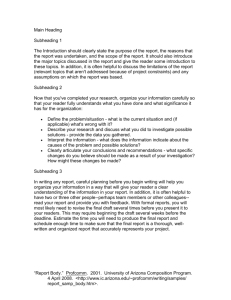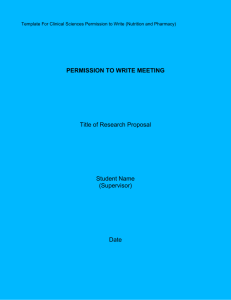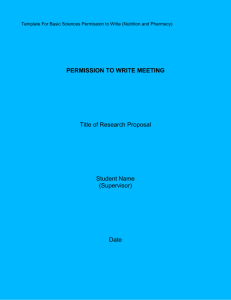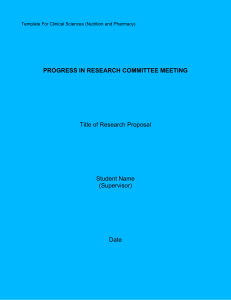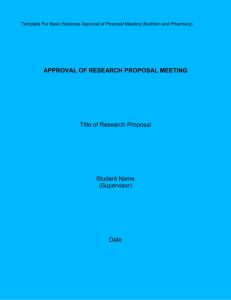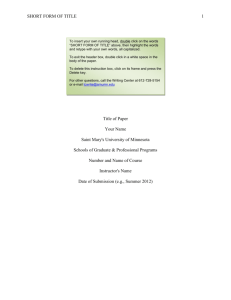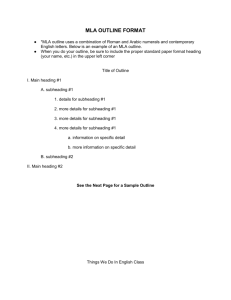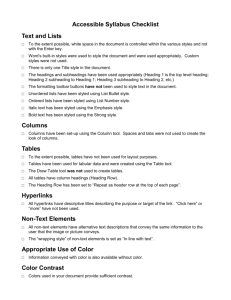Running Head: SHORTENED FORM OF TITLE
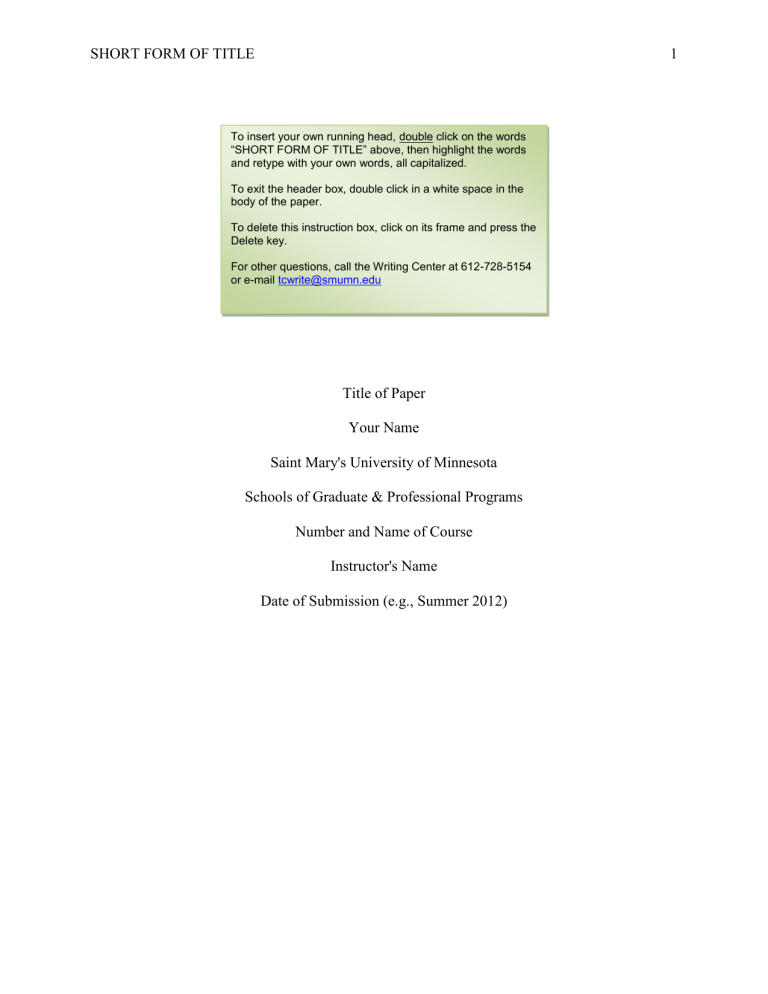
SHORT FORM OF TITLE
To insert your own running head, double click on the words
“SHORT FORM OF TITLE” above, then highlight the words and retype with your own words, all capitalized.
To exit the header box, double click in a white space in the body of the paper.
To delete this instruction box, click on its frame and press the
Delete key.
For other questions, call the Writing Center at 612-728-5154 or e-mail tcwrite@smumn.edu
Title of Paper
Your Name
Saint Mary's University of Minnesota
Schools of Graduate & Professional Programs
Number and Name of Course
Instructor's Name
Date of Submission (e.g., Summer 2012)
1
SHORT FORM OF TITLE
Executive Summary
Limit the executive summary to one page.
2
SHORT FORM OF TITLE
Table of Contents
Table of Figures .........................................................................................................................
3
Chapter 1, Organizational Leadership Issue .............................................................................. x
First Heading ................................................................................................................. x
Second Heading ............................................................................................................. x
Third Heading ................................................................................................................ xx
Chapter 2, Literature Review ..................................................................................................... xx
First Heading ................................................................................................................. xx dots after each heading. To make an entry, type your heading, press Tab, and type the page number.
Second Heading ............................................................................................................. xx
Do not use the Tab key to indent on this page. Instead, if you need to indent, use the Ruler Bar or the Space Bar.
Third Heading ................................................................................................................ xx
Once you leave the Table of Contents page, the Tab key will
Fifth Heading ................................................................................................................. xx
Chapter 3, Recommendations for Change ................................................................................. xx
First Heading ................................................................................................................. xx
Second Heading ............................................................................................................. xx
Third Heading ................................................................................................................ xx
Chapter 4, Implementation Strategies ........................................................................................ xx
First Heading ................................................................................................................. xx
Second Heading ............................................................................................................. xx
Third Heading ................................................................................................................ xx
References .................................................................................................................................. xx
Appendix A ................................................................................................................................ xx
Appendix B ................................................................................................................................ xx
SHORT FORM OF TITLE
Table of Figures
Figure 1, Title of Figure ............................................................................................................. x
Figure 2, Title of Figure ............................................................................................................. xx
4
If you use figures in your document, list them in order (with titles) on a Table of Figures page after the Table of Contents.
If you do not use figures in your document, omit this page.
Treat all illustrations as figures. Do not differentiate between tables and figures. Number figures in the order in which they appear in the text.
Before presenting a figure in your text, provide a "call out" to the reader. A call out can appear in parentheses (see Figure
2) or as a stand-alone sentence like the following: Figure 3 illustrates the flow of information from clients to dispatchers .
SHORT FORM OF TITLE 5
Title of Paper
Chapter 1: Organizational Leadership Issue
Level 1 heading (chapter heading)
Change it to “Organizational
Leadership Opportunity” or
“Organizational Leadership Issue” as appropriate for your topic.
Introduction
Level 2 heading, chapter subdivision
Limit the introduction to two or three paragraphs. Provide a brief overview of the organizational leadership issue/opportunity and a roadmap of the entire paper for the reader.
Description of the Organization Level 2, chapter subdivision
Provide the necessary background for the reader to understand the leadership issues and opportunities you will present below. This may include detail on the organization’s purpose, products, leadership, strategy, and culture. It may include a discussion of trends in the industry, and challenges facing the organization as a result. Include enough information that the reader will clearly understand the next section. Support your assertions with evidence. Be careful, though, not to include unnecessary information that dilutes your main themes. Use further sublevel headings (level 3, level 4 …) as needed to help the reader understand the organization of this section.
Organizational Leadership Opportunity Level 2, chapter subdivision
You can rename this section “Organizational Leadership Issues” if that’s more appropriate for your topic. Based upon the background above, what opportunities or issues are implied for the organization’s leadership? These opportunities or issues should lead the reader directly to the research questions presented below. Be careful not to present recommended solutions in this section.
Significance of the Issue
Level 2, chapter subdivision
In this section, describe why the topic is important to the organization. This will build the case for leadership to take action and follow your recommendations. What positive
SHORT FORM OF TITLE outcomes could occur if the opportunities are realized? What negative outcomes might result if
6 issues persist?
Level 3 chapte
Subheading one. Use this heading style if necessary to subdivide a larger section.
Begin the paragraph on the same line as the indented heading. Allow additional lines to wrap to the left margin of the document.
Level 3 chapte
Subheading two. Remember that headings subdivide sections, hence the need for at least two headings for each level (i.e., a section cannot be divided into "one").
Researching the Issue Level 2, chapter subdivision
Provide a short introduction for this section which ties the organizational opportunity or issue to the research questions.
Level 3
33
Research question(s). Under this heading, state the question [or questions] intended to be addressed by the literature review in the following chapter. These questions should directly pertain to leadership opportunity or issue described above; you should include 1-3 research questions. These questions are critical to your literature review, so be thoughtful in selecting every word of each question. You might write something like this: The research question[s] is[are] the following: [State question or list questions using proper APA seriation guidelines].
Level 3
33
Scope and limitations. This paragraph explains the focus of your topic. What does the focus include? Most importantly, what will not be included and why? What out-of-scope aspects would be appropriate topics for further analysis and research?
Level 3
33
Definition of terms. Define the terms that have a specialized meaning in the context of your paper, or new terms that may be unfamiliar to a wide professional audience. Do not define terms you expect a professional audience will already know unless you are using the terms in a narrow, specialized, or unconventional way in your paper. General terms like "poverty" may
SHORT FORM OF TITLE 7 need explanation for your context (what poverty guidelines apply in your paper?), but it does not need definition in a general sense. Do not use dictionaries, encyclopedias, or wikis. Use scholarly and professional literature, and cite sources for the definitions you provide. If you have many terms, you can write definitions in a numbered list. Definitions should be complete sentences.
SHORT FORM OF TITLE 8
Chapter 2: Literature Review
Introduction
The introduction should provide a clear linkage to the research questions delineated in the first chapter. The headings below are an example of the way style 3 and style 4 headings might be used to divide a literature review. However, the number and style of headings used will vary according to the topics and organization structure you select.
If you have multiple research questions, subdivide the literature review accordingly.
Within the discussion for each research question, it is likely that many aspects will be described, so use further subheadings to clarify the structure for the reader. Summarize the findings for each research question, and provide overall conclusions and analysis in the final section.
First Chapter 2 Subdivision
Subheading one.
Subheading two.
Second Chapter 2 Subdivision
Subheading one.
Subheading two.
Subheading three.
Third Chapter 2 Subdivision
Conclusions
SHORT FORM OF TITLE
Chapter 3: Recommendations for Change
Introduction
This section should provide your recommendations for change, in order to address the leadership opportunities or issues. These recommendations should be supported by findings in
9 the literature review. You may also use other academic articles and books as supporting evidence, including those from prior MAOL courses. Organize the section clearly and provide the reader with a roadmap.
First Chapter 3 Subdivision
Subheading one.
Subheading two.
Second Chapter 3 Subdivision
Subheading one.
Subheading two.
Summary
SHORT FORM OF TITLE
Chapter 4: Implementation Strategies
10
Introduction
This section should describe strategies for implementation of your general recommendations. How should the recommended changes be implemented? What specific steps should be taken, and in what order? What are the major milestones? What obstacles or resistance may be encountered? How may success be evaluated or measured? Support your assertions. This section provides an excellent opportunity to demonstrate synthesis of learnings from prior courses. You may choose to discuss general strategies and factors regarding implementation, or you may choose to provide a more detailed project timeline. Organize the section clearly and provide the reader with a roadmap. At the end, provide a conclusion to the entire paper.
First Chapter 4 Subdivision
Subheading one.
Subheading two.
Second Chapter 4 Subdivision
Subheading one.
Subheading two.
Conclusion
SHORT FORM OF TITLE 11
References
Aboher, M. (2008, May 29). Hot ticket in b-school: Bringing life values to corporate ethics. The
New York Times.
Retrieved from http://www.nytimes.com/2008/05/29/business/smallbusiness/29shift.html?_r=1&oref=slo gin
Bregman, M. (Writer, Director). (2007). Carlito's way: Rise to power [Motion picture, DVD].
United States: Universal Studios.
Conger, J. A., & Kanungo, R. N. (1988). Charismatic leadership: The elusive factor in organizational effectiveness. San Francisco, CA: Jossey-Bass.
Dionne, S. D., Yammarino, F. J., Atwater, L. E., & Spangler, W. D. (2004). Transformational leadership and team performance. Journal of Organizational Change Management ,
17 (2), 177-193. doi:10.1108/09534810410530601
Elias, M. J., O’Brien, M. U., & Weissberg, R. P. (2006, December). Transformative leadership for social-emotional learning. Student Services , 10-13. Retrieved from http://www.nasponline.org/resources/principals/Social%20Emotional%20Learning%20N
ASSP.pdf
Friedman , H . H., & Friedman, L. (2008). Taking happiness seriously in today's business environment. Journal of International Marketing & Marketing Research , 33 (1), 3-17,
Friedman, H. H., & Langbert , M. (n.d.). Abraham as a transformational leader . Retrieved
September 17, 2008, from http://academic.brooklyn.cuny.edu/economic/friedman/Abraham-
GreatTranforLeader.htm
SHORT FORM OF TITLE 12
Liden, R. C., Wayne, S. J., Zhao, H., & Henderson, D. (2008). Servant leadership: Development of a multidimensional measure and multi-level assessment . The Leadership
Quarterly , 19 (2), 161-177 .
Lunenburg, F. C. (2006). Organizational theories. In Encyclopedia of educational leadership and administration (Vol. 2, pp. 717-720). Thousand Oaks, CA: Sage Reference.
Trottier, T., Van Wart, M., & Wang, X. (2008). Examining the nature and significance of leadership in government organizations. Public Administration Review , 68 (2), 319-333. doi:10.1111/j.1540-6210.2007.00865
An attempt was made to provide you with a variety of source models on this sample reference page. You will find explanations of these references on the Writing Center Web page where you found this document.
For information about many other types of sources, go to Chapter 7 of the APA manual.
To delete this instruction box, double click on its frame and press the Delete key.
If you have trouble formatting this document, you may have accidentally deleted an invisible formatting command. For help, send your document as an e-mail attachment to the Writing
Center tcwrite@smumn.edu . State your questions in the body of the e-mail. Provide your name, program, and telephone number.
See Appendix model next page
SHORT FORM OF TITLE 13
Appendix A
Title of Appendix
Appendixes are optional. For instructions on typing appendixes, see p. 39 of the APA manual. For other questions about appendixes, use the index in the back of the manual. If only one appendix is required, label it "Appendix," without a letter.
